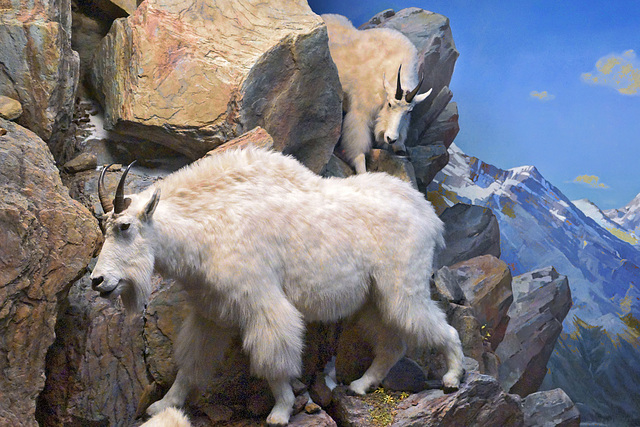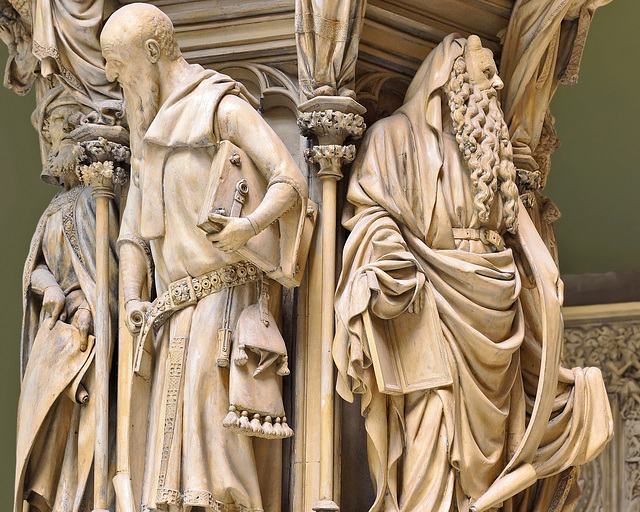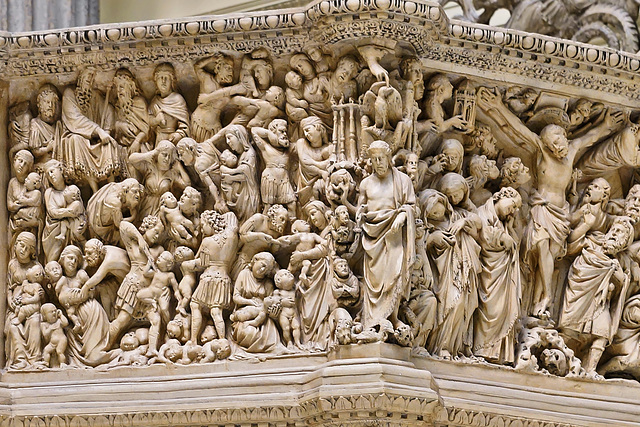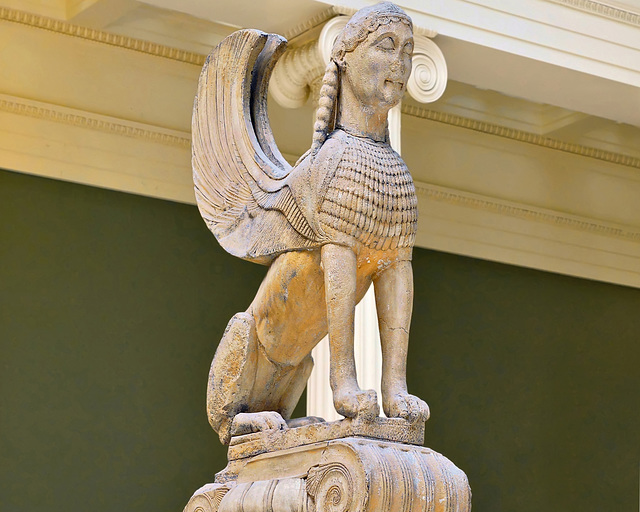
Pittsburgh, Pennsylvania
Mountain Goats Diorama – Carnegie Museum of Natural History, Pittsburgh, Pennsylvania
Alaskan Black Bears Diorama – Carnegie Museum of Natural History, Pittsburgh, Pennsylvania
Black bears are the smallest of the North American bears. Adult bears stand about 29 inches (.73 m) at the shoulders and measure about 60 inches (1.5 m) from nose to tail. The tail is about two inches long. Males are larger than females. An average adult male in spring weighs about 180-200 pounds (81.8 to 90.9 kg). They are considerably lighter when they emerge from winter dormancy and may be 20 percent heavier in the fall when they are fat.
The color of this bear over its entire range varies from jet black to white. A very rare white or creamy phase occurs on Kermode Island and vicinity in British Columbia. Three colors are common in Alaska. Black is the most often encountered color, but brown or cinnamon bears are often seen in South-central Alaska and the Southeast mainland. The rare blue (glacier) phase may be seen in the Yakutat area and has been reported in other parts of Southeast Alaska. Only the black color phase is seen on the islands of Southeast. Black bears may have a patch of white hair on the fronts of their chests.
Black bears are most easily distinguished from brown bears by their straight facial profile and their claws which are sharply curved and seldom over 1½ inches in length. Positive identification can be made by measuring the upper rear molar which is never more than 1¼ inches long in the black bear and is never less than that in a brown bear. Black bears have adequate senses of sight and hearing. They do have, however, an outstanding sense of smell.
Triceratops – Carnegie Museum, Forbes Avenue, Pittsburgh, Pennsylvania
"Dinosaur" Fish – Carnegie Museum, Forbes Avenue, Pittsburgh, Pennsylvania
Xiphactinus (from Latin and Greek for "sword-ray") is an extinct genus of large, 4.5 to 6 m (15 to 20 feet) long predatory marine bony fish that lived during the Late Cretaceous. When alive, the fish would have resembled a gargantuan, fanged tarpon (to which it was, however, not related). Xiphactinus were voracious predators. At least a dozen specimens of X. audax have been collected with the remains of large, undigested or partially digested prey in their stomachs.
Dragonstone – Carnegie Museum, Forbes Avenue, Pittsburgh, Pennsylvania
This beautiful Septarian nodule, on display at the Carnegie Natural Histpry Museum in Pittsburgh, is from England. Septarian Nodules, also called Dragonstone, are concretions of sedimentary rock containing radiating fissures called "septaria", (from the Latin word septum; meaning "partition", referring to the cracks/separations in this stone). Septarian cavities fill with clay ironstone and the radiating fissures usually contain crystals of buttery calcite, though siderite or pyrite coatings are also occasionally present showing bright reddish and golden colours. In many cases, the brown tones are aragonite, the grey parts are limestone and the white or clear sections are barite. Some septaria may also contain small calcite stalagtites and well-shaped millimetric pyrite single crystals.
The Well of Moses – Carnegie Museum, Forbes Avenue, Pittsburgh, Pennsylvania
Claus Sluter (1350-1406) was the most creative and powerful sculptor of the late middle ages. This Netherlandish master worked in the service of the Dukes of Burgundy. His artistic genius created art objects that are still seen today in Dijon, France and his greatest creation was the Well of Moses (Moses Fountain).
The Carthusian Monastery (better known as the Chartreuse de Champmol) was intended to be the burying place at the end of the 14th century for the Duke of Burgundy (a prince of the royal house of France), Philip the Bold and his family. Located just outside Philip’s Burgundian capital of Dijon, this monastery was originally chartered in 1385. It became a prodigious art center which drew many other artists from Paris and Flanders. It was here that Claus Sluter executed the Well of Moses. This large famous hexagonal fountain was built in the center of the cloister between 1396 and 1404. Carved in stone from Asnières, France it was a premier artwork of its time and just one of Sluter’s representative artistic achievements under Philip the Bold and Philip’s son John the Fearless (1371-1419).
The most famous of the prophets, Moses, seems theatrically angry. The dramatic folds in the voluminous drapery add to the expression of the figure. The horns on his head are typical in medieval art--a mistranslation of the Bible for "rays" of light. Standing next to Moses is a figure of the prophet Isaiah. And next tp Isaiah we see the head of the prophet Daniel (dressed as a Burgundian courtier of the late 14th century).
The fountain served as a cemetery cross and also as an irrigation source for the monastery’s orchard. The monastery functioned until the time of the French Revolution when it was mostly destroyed. The hexagonal base with the figures of the six personalities of the Hebrew Bible who were thought to have foreseen the coming of Jesus (Moses, David, Jeremiah, Zachariah, Daniel and Isaiah) fortunately survived. Sluter’s Calvary group and the crucifix were damaged during the first half of the 18th century and then these wonders of art and faith, powerful symbols of domination by the joined powers of church and state, were destroyed in 1791.The charterhouse was also mostly destroyed during the French Revolution.
A cast of part of the fountain is displayed in the Hall of Architecture at the Carnegie Museum of Art in Pittsburgh.
The Slaughter of the Innocents and the Crucifixion – Carnegie Museum, Forbes Avenue, Pittsburgh, Pennsylvania
The Hall of Architecture at the Carnegie Museum of Art displays a cast of the pulpit from Siena Cathedral. The pulpit of the Siena Cathedral which was created between the fall of 1265 and the fall of 1268 is an octagonal structure that was sculpted by Nicola Pisano and his assistants. On the eight panels, there are carved reliefs that "represent a Christological cycle from the Visitation to the Last Judgment.
The Fourth Panel – which takes the central spot upon the pulpit – depicts the Massacre of the Innocents. It is the only panel that does not contain Jesus or his family. In fact it is concerned with the absence of Jesus, because it depicts King Herod’s decreeing the mass killing of the baby boys in Bethlehem to avoid the prophecy that the "King of Jews" would take his throne. This panel is a good example of Nicola’s attention to emotion and movement. The struggle between the families clutching their children and the Roman soldiers (wearing traditional roman uniform) is true classical form. None of the characters is arranged stiffly; rather they lunge, shirk and squirm which sharpens the dramatic effect.
To the right of the massacre, stands the image Jesus and the Four Evangelists. This carving introduces the next relief panel depicting the Crucifixion. In the center on the panel Jesus hangs upon the cross traditionally shown with his head falling to the side and modestly covered in a loin cloth. Surrounding Jesus is a scene of onlookers and mourners. To the left of Jesus stands the image of Mary grieving. Her stance and emotion are typical of the 13th century during which it became common to depict the Virgin as swooning. This panel is also a good example of Nicola’s understanding of depth with the foreground figures being the larger than the ones in the background.
The Naxian Sphynx – Carnegie Museum, Forbes Avenue, Pittsburgh, Pennsylvania
Guided by the view that a replica of a masterpiece was superior to a mediocre original, collectors from the time of Rome’s first emperor until the early 20th century amassed great plaster-cast collections of recognized masterworks. As early as the fourth century BCE, the Greeks made plaster casts of famous marble statues. In Roman times, the passion for Greek sculpture resulted in the reproduction of works of art. Plaster casts were also popular during the Renaissance, when the “rebirth” of antiquity influenced artistic taste. By the late 18th century, inspired by new archaeological finds, collections of plaster casts could be found in most European cities.
In the 19th century, the demand for plaster casts skyrocketed. As centerpieces of the great international fairs, casts nourished nationalistic pride, while independent cast “galleries” served the Victorian fervour for education by providing instruction to both the amateur and the art student. Also, the dominance of historical styles in premodern architecture required that the architecture student study the outstanding buildings of the past; in this pursuit, plaster casts played an essential role.
A cast of votive column of the Naxians (The Colossal Naxian Sphinx) is on display in the Hall of Architecture at the Carnegie Museum of Art. The original, currently located in the Archaeological Museum of Delphi, Greece, dates from 570-560 BCE.
Carnegie Museum – Forbes Avenue, Pittsburgh, Pennsylvania
The Carnegie Institute is a massive Beaux Arts cultural complex that contains a Carnegie library (one of the best libraries in the country but not visible in this photo), music hall, natural history museum, and art museum. Seventy feet above two entrances to the Alden and Harlow additions to the original Carnegie Institute are four groups of allegorical figures representing Literature, Music, Art, and Science.
Jump to top
RSS feed- Latest items - Subscribe to the latest items added to this album
- ipernity © 2007-2024
- Help & Contact
|
Club news
|
About ipernity
|
History |
ipernity Club & Prices |
Guide of good conduct
Donate | Group guidelines | Privacy policy | Terms of use | Statutes | In memoria -
Facebook
Twitter










